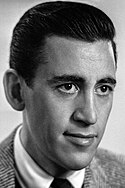J.D. Salinger Quote
When Seymour and I were five and three, Les and Bessie played on the same bill for a couple of weeks with Joe Jackson -- the redoubtable Joe Jackson of the nickel-plated trick bicycle that shone like something better than platinum to the very last row of the theater. A good many years later, not long after the outbreak of the Second World War, when Seymour and I had just recently moved into a small New York apartment of our own, our father -- Les, as he'll be called hereafter -- dropped in on us one evening on his way home from a pinochle game. He quite apparently had held very bad cards all afternoon. He came in, at any rate, rigidly predisposed to keep his overcoat on. He sat. He scowled at the furnishings. He turned my hand over to check for cigarette-tar stains on my fingers, then asked Seymour how many cigarettes he smoked a day. He thought he found a fly in his highball. At length, when the conversation -- in my view, at least -- was going straight to hell, he got up abruptly and went over to look at a photograph of himself and Bessie that had been newly tacked up on the wall. He glowered at it for a full minute, or more, then turned around, with a brusqueness no one in the family would have found unusual, and asked Seymour if he remembered the time Joe Jackson had given him, Seymour, a ride on the handle bars of his bicycle, all over the stage, around and around. Seymour, sitting in an old corduroy armchair across the room, a cigarette going, wearing a blue shirt, gray slacks, moccasins with the counters broken down, a shaving cut on the side of his face that I could see, replied gravely and at once, and in the special way he always answered questions from Les -- as if they were the questions, above all others, he preferred to be asked in his life. He said he wasn't sure he had ever got off Joe Jackson's beautiful bicycle.
When Seymour and I were five and three, Les and Bessie played on the same bill for a couple of weeks with Joe Jackson -- the redoubtable Joe Jackson of the nickel-plated trick bicycle that shone like something better than platinum to the very last row of the theater. A good many years later, not long after the outbreak of the Second World War, when Seymour and I had just recently moved into a small New York apartment of our own, our father -- Les, as he'll be called hereafter -- dropped in on us one evening on his way home from a pinochle game. He quite apparently had held very bad cards all afternoon. He came in, at any rate, rigidly predisposed to keep his overcoat on. He sat. He scowled at the furnishings. He turned my hand over to check for cigarette-tar stains on my fingers, then asked Seymour how many cigarettes he smoked a day. He thought he found a fly in his highball. At length, when the conversation -- in my view, at least -- was going straight to hell, he got up abruptly and went over to look at a photograph of himself and Bessie that had been newly tacked up on the wall. He glowered at it for a full minute, or more, then turned around, with a brusqueness no one in the family would have found unusual, and asked Seymour if he remembered the time Joe Jackson had given him, Seymour, a ride on the handle bars of his bicycle, all over the stage, around and around. Seymour, sitting in an old corduroy armchair across the room, a cigarette going, wearing a blue shirt, gray slacks, moccasins with the counters broken down, a shaving cut on the side of his face that I could see, replied gravely and at once, and in the special way he always answered questions from Les -- as if they were the questions, above all others, he preferred to be asked in his life. He said he wasn't sure he had ever got off Joe Jackson's beautiful bicycle.
Related Quotes
About J.D. Salinger
The Catcher in the Rye (1951) was an immediate popular success; Salinger's depiction of adolescent alienation and loss of innocence was influential, especially among adolescent readers. The novel was widely read and controversial, and its success led to public attention and scrutiny. Salinger became reclusive, publishing less frequently. He followed Catcher with a short story collection, Nine Stories (1953); Franny and Zooey (1961), a volume containing a novella and a short story; and a volume containing two novellas, Raise High the Roof Beam, Carpenters and Seymour: An Introduction (1963). Salinger's last published work, the novella Hapworth 16, 1924, appeared in The New Yorker on June 19, 1965.
Afterward, Salinger struggled with unwanted attention, including a legal battle in the 1980s with biographer Ian Hamilton and the release in the late 1990s of memoirs written by two people close to him: Joyce Maynard, an ex-lover; and his daughter, Margaret Salinger.
